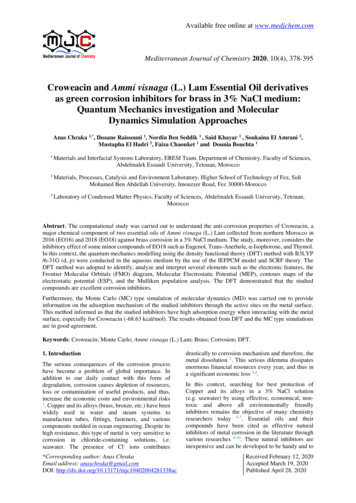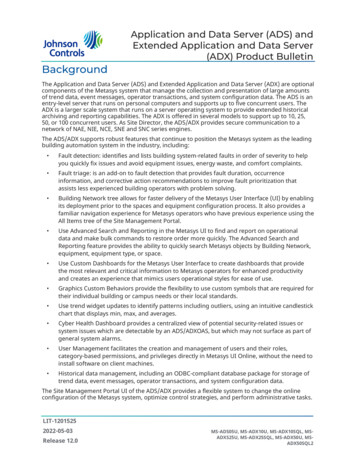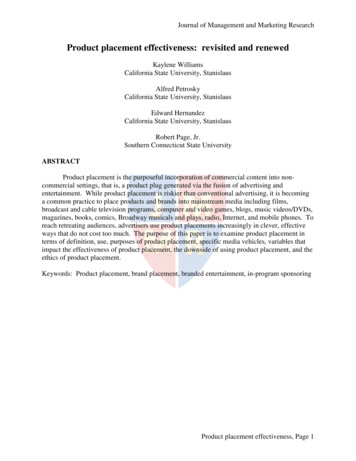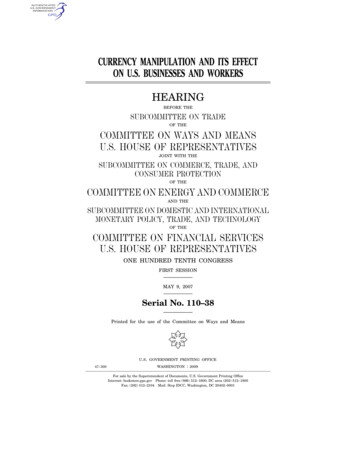
Transcription
Available free online at www.medjchem.comMediterranean Journal of Chemistry 2020, 10(4), 378-395Croweacin and Ammi visnaga (L.) Lam Essential Oil derivativesas green corrosion inhibitors for brass in 3% NaCl medium:Quantum Mechanics investigation and MolecularDynamics Simulation ApproachesAnas Chraka 1,*, Ihssane Raissouni 1, Nordin Ben Seddik 1 , Said Khayar 1 , Soukaina El Amrani 2,Mustapha El Hadri 3, Faiza Chaouket 1 and Dounia Bouchta 11Materials and Interfacial Systems Laboratory, ERESI Team. Department of Chemistry, Faculty of Sciences,Abdelmalek Essaadi University, Tetouan, Morocco2Materials, Processes, Catalysis and Environment Laboratory. Higher School of Technology of Fez, SidiMohamed Ben Abdellah University, Imouzzer Road, Fez 30000-Morocco3Laboratory of Condensed Matter Physics, Faculty of Sciences, Abdelmalek Essaadi University, Tetouan,MoroccoAbstract: The computational study was carried out to understand the anti-corrosion properties of Croweacin, amajor chemical component of two essential oils of Ammi visnaga (L.) Lam collected from northern Morocco in2016 (EO16) and 2018 (EO18) against brass corrosion in a 3% NaCl medium. The study, moreover, considers theinhibitory effect of some minor compounds of EO18 such as Eugenol, Trans-Anethole, α-Isophorone, and Thymol.In this context, the quantum mechanics modelling using the density functional theory (DFT) method with B3LYP/6-31G (d, p) were conducted in the aqueous medium by the use of the IEFPCM model and SCRF theory. TheDFT method was adopted to identify, analyze and interpret several elements such as the electronic features, theFrontier Molecular Orbitals (FMO) diagram, Molecular Electrostatic Potential (MEP), contours maps of theelectrostatic potential (ESP), and the Mulliken population analysis. The DFT demonstrated that the studiedcompounds are excellent corrosion inhibitors.Furthermore, the Monte Carlo (MC) type simulation of molecular dynamics (MD) was carried out to provideinformation on the adsorption mechanism of the studied inhibitors through the active sites on the metal surface.This method informed us that the studied inhibitors have high adsorption energy when interacting with the metalsurface, especially for Croweacin (-68.63 kcal/mol). The results obtained from DFT and the MC type simulationsare in good agreement.Keywords: Croweacin; Monte Carlo; Ammi visnaga (L.) Lam; Brass; Corrosion; DFT.1. IntroductionThe serious consequences of the corrosion processhave become a problem of global importance. Inaddition to our daily contact with this form ofdegradation, corrosion causes depletion of resources,loss or contamination of useful products, and thus,increase the economic costs and environmental risks1. Copper and its alloys (brass, bronze, etc.) have beenwidely used in water and steam systems tomanufacture tubes, fittings, fasteners, and variouscomponents molded in ocean engineering. Despite itshigh resistance, this type of metal is very sensitive tocorrosion in chloride-containing solutions, i.e.seawater. The presence of Cl- ions contributes*Corresponding author: Anas ChrakaEmail address: anaschraka@gmail.comDOI: tically to corrosion mechanism and therefore, themetal dissolution 2. This serious dilemma dissipatesenormous financial resources every year, and thus ina significant economic loss 3,4.In this context, searching for best protection ofCopper and its alloys in a 3% NaCl solution(e.g. seawater) by using effective, economical, nontoxic and above all environmentally friendlyinhibitors remains the objective of many chemistryresearchers today 5-7. Essential oils and theircompounds have been cited as effective naturalinhibitors of metal corrosion in the literature throughvarious researches 8-10. These natural inhibitors areinexpensive and can be developed to be handy and toReceived February 12, 2020Accepted March 19, 2020Published April 28, 2020
Mediterr.J.Chem., 2020, 10(4)A. Chraka et al.meet the requirements of the industrial sector 11,12.These natural corrosion inhibition molecules mayform a protective layer by adsorbing on the metalsurface via covalent bonds (chemisorption) and/orelectrostatic bonds (physisorption) 13. The corrosioninhibiting properties of this type of compound are dueto the capacity of heteroatoms and the π electrons ofthe aromatic ring to share electrons with the metalsurface, which leads to the formation of a protectivefilm 14,15.As mentioned earlier, although essential oils arecommonly used as green inhibitors in several studies,the understanding of their effect and their corrosioninhibiting mechanisms has not been well clarified.This may be due in part to the presence of manymolecules belonging to different chemical families(Monoterpenes, Terpenes, Phenols, Sesquiterpenes,etc.) in essential oils. This makes it challenging toidentify the active compound with the inhibitoryproperty. Therefore, we have proposed to usecomputational chemistry as one of the solutionsadopted in this work to solve this problem.Traditionally, inhibition performance tests aregenerally performed by the main knownelectrochemical methods such as polarization curves,electrochemical impedance spectroscopy (EIS) andweight loss. However, all of these techniques areexpensive and time-consuming to study the inhibitionprocesses 16. Currently, computational chemistry isused in all branches of chemistry, including the studyof corrosion inhibitors, where it has become the mostused tool to understand better the inhibitory powerand the interaction mechanisms with the metal surface17. This technique has multiple advantages to evaluatethe inhibition performance and to explore theinhibition mechanism more precisely and at lowercost 18. Within the same context, the theory offunctional density (DFT), as a theoretical tool, hassuccessfully shown the ability to define with highaccuracy the geometric molecular properties, bindingenergies, as well as assessing the interaction betweenthe inhibitor and the metal surface 19,20. Thistheoretical study of corrosion inhibitors is notconsidered complete unless simulation of moleculardynamics is used to give a more realistic and perfectvision of what is occurring experimentally.As a part of our ongoing research project, in ourrecently published paper 21, we discussed theinhibitory performances of two Ammi visnaga (L.)lam extracts collected in 2016 (EO16) and 2018(EO18) on the corrosion of brass in 3% NaCl mediumusing electrochemical methods. These methods arebased on the potentiodynamic polarization curves andelectrochemical impedance spectroscopy (EIS). In thesame approach, this paper focused on comparing thesimulated theoretical results with their experimentalcounterpart. To this end and towards a betterunderstanding of the inhibitory power of these twooils’ components, the inhibitory power of the majoritycompound (Croweacin) with all the other compounds379were analyzed and compared. The aim is to providesatisfactory answers of the studied oils inhibitionprocess through quantum mechanics (QM) modellingin the aqueous phase using DFT- B3LYP/6-31G(d,p)IEFPCM model and with the analysis of the electronicdistribution of the studied compounds. Besides,molecular dynamic simulation based on the MonteCarlo (MC) method was adopted to complete the DFTcalculations and to look for a logical explanation ofthe high inhibitory power of EO18 compared toEO16. Besides, since brass was used in theexperimental study and because copper constitutes thelargest fraction of brass 21, we intended to comprehendthe interaction of the studied inhibitors on the surfaceof copper.2. Materials and methods2.1. Quantum mechanics methodologyTo get the analysis of the studied compoundselectronic features in this work, the quantummechanics (QM) computations utilizing densityfunctional theory (DFT) were conducted 15,22. Allcomputational studies were carried out with theGaussian (09W) program 23. The optimized geometrywas carried using the DFT method in the scheme ofthe hybrid function of Becke three-parameters; Lee,Yang, and Parr (B3LYP) with the 6-31G(d,p) basic sethas been used to provide electronic-structureproperties and precise geometries for a large numberof organic compounds 24. The DFT study was done inan aqueous medium using the Integral EquationFormalism Polarizable Continuum (IEFPCM) modeland self-consistent reaction field (SCRF) theory 25 tosimulate the experimental conditions of the corrosivemedium. Since the corrosive medium is neutral, allcalculations were performed in the neutral form of thestudied molecules. The results obtained werevisualized with the Gaussview software 26.In addition, the electronic-structure parametersanalyzed here include the energy of the highestoccupied molecular orbital (EHOMO), the energy of thelowest unoccupied molecular orbital (ELUMO), the gapenergy ( Egap), the ionization potential (I), theelectron affinity (A), the dipole moment (μ), theelectronegativity (χ), the electrophilicity index (ω),the hardness (η), the softness (σ), and the fraction ofelectrons transferred (ΔN).To understand the fraction of electrons transferred(ΔN) between the brass and the inhibitors, we rely oncopper (ΔNCu) because of its high percentage in thisalloy (brass) 21. According to the simple chargetransfer by donation and back-donation ( Eback-donation)model proposed by Gomez et al. 27, an electronicback-donation process could occur governing theinteraction between the inhibitor molecule and themetal surface. The ΔEback-donation implies that whenη 0 and ΔEback-donation 0 the charge transfer to amolecule, followed by a back-donation from themolecule, is energetically favored. All these
Mediterr.J.Chem., 2020, 10(4)A. Chraka et al.parameters have been calculated according toequations (1-9) as indicated in the literature 24,3. Egap ELUMO EHOMO(1)I EHOMO(2)A ELUMO(3)( I A)X 2(4) ( I A)2(5)1(6) X22 N Cu (7)X Cu X inh2( Cu inh )Where XCu 4,48 eV and ηCu 0 eV E back donation 4(8)28.(9)2.2. Molecular dynamics simulationMolecular dynamics simulation of the MetropolisMonte Carlo (MC) type implemented using MaterialStudio 8.0 software from Accelrys Inc. 29 was used toassess the nature of the interaction between theinhibitor and the metal. We built the adsorptionsystem on the surface of copper (Cu (111)),considering that brass is one of its alloys, in additionto being the dominant element of this metal 21. Theselected crystalline surface Cu (111) is the moststable, as the literature had shown 30,31. For thetheoretical study to be homogeneous and sequential,we have extracted the selected inhibitory molecules,which has been studied in its neutral forms in theaqueous medium using DFT at the B3LYP / 6-31G(d, p) level to be used in the simulation system of MC.The calculations were applied using the COMPASS 32at 298 K force field to optimize the structures of allsystem components and represent a technologicalbreakthrough in the force field method. TheCOMPASS force field is the first ab initio forcefield33which allows precise and simultaneous predictionof chemical properties (structural, conformational,vibrational, etc.) including the one in the condensedphase (equation of state, cohesive energies, etc.) for awide range of chemical systems 17. The simulation of380MC between the inhibitors and the Cu atoms wascarriedoutinasimulationbox(20.44 20.44 38.34Å) with boundary conditions 34.The Cu (111) surface was constructed from theoptimized crystal surface using a 4 x 4 super-cell, andthen a 30Å vacuum layer is maintained on the Cu(111) surface.3. Results and Discussion3.1. Quantum mechanics resultsThe use of ab initio QM computations based on DFTwas evaluated to comprehensively understand theelectrochemical results which showed a bestinhibitory effect of EO18 (E 95.65 (%)) comparedto EO16 (E 85 (%)) 21. This method allows in-depthanalysis of the quantum chemical parametersstructures of major molecules (Croweacin andLinalol) and minor compounds (Monoterpenes,Phenols, Phenylpropenes, Terpene Alcohols, EthylAlcohols and Sesquiterpenes) of these two EOs 21.From a quantum chemical point of view, it is knownfrom the literature that adsorption of moleculesinhibiting corrosion on a metal surface takes place bymeans of a donor-acceptor mechanism 35. Suchinteraction occurs between sites rich in electrons withan electron-donating capacity, namely heteroatoms,aromatics, and multiple bonds which characterize theinhibitory molecule and the sites poor in electronswith an electron acceptance capacity thatcharacterizes metal atoms on the other hand.The DFT method used was adapted to rationalize thisadsorption mechanism. Thus, we have calculated theelectronic parameters such as EHOMO, ELUMO, ΔEgap,and μ. These parameters will provide us withpreliminary information of the compoundsresponsible for the inhibition in EO16 and EO18(Table 1).Generally, the donation of electrons and theacceptability of an inhibitory molecule are determinedby the Frontier Molecular Orbitals (FMO). The studyof the highest occupied molecular orbit (HOMO) andthe lowest unoccupied molecular orbit (LUMO) isessential to explain the molecules chemical reactivity.It is known that one of the energy values of the highestoccupied molecular orbital (EHOMO) is higher and thatthe energy of the lowest unoccupied molecular orbital(ELUMO) is lower. This leads the electron transfertendency to an appropriate acceptor molecule andfacilitates adsorption on the metal surface 36.Furthermore, the difference between these energylevels ( Egap) is a vital descriptor depending on thereactivity of the inhibitory molecule regarding theadsorption on the metal surface. The lower is the valueof Egap indicate the higher is the reactivity of theinhibitor and thus the excellent adsorption ability 37.
Mediterr.J.Chem., 2020, 10(4)A. Chraka et al.381Table 1. Quantum chemical parameters for the studied molecules of EO16 and EO18 in their neutral formsobtained in the aqueous phase with the DFT at the B3LYP/6-31G (d,p) eV)μ(Debye)β- Pinene-6.310.686.99-0.686.310.932-Methylpropyl butanoate-7.430.307.64-0.307.432.43Amyl 2.149.85-2.147.710.80Isobutyl l 2-methylbutyrate-7.360.277.63-0.277.362.45Amyl 80.015.69-0.015.682.08Citronellyl l valerate-6.220.216.43-0.216.222.65Bornyl 870.005.871.87Geranyl 48-0.624.860.625.481.87Citronellyl 3.25(Z) Farnesyl acetate-6.050.156.20-0.156.053.17EO16EO18The results of EO16 compounds (Table 1) revealedthat the highest energy EHOMO characterizes theCroweacin -5.68 eV, the lowest energyELU MO 0.01eV, and the lowest value of Egap (5.69eV) compared to other molecules. Thus, Croweacincould perform better as a corrosion inhibitor.Croweacin revealed to have a large dipole momentvalue. This latter parameter proved to enhance theadsorption between the Croweacin molecule and themetal surface 38. In this analysis, we also noted thatalmost all the EO16 compounds, in addition to thesecond major compound (Linalol), have high dipolemoments. Although the obtained values of thequantum parameters (EHOMO, ELUMO and ΔEgap) forthese compounds (Linalool, β- Pinene, Amylisobutyrate, γ-Terpinene,etc.) are not equivalent tothose obtained for Croweacin, it turned out, from thiscalculation, that EO16 compounds have no inhibitoryperformance except Croweacin. These results showthat he does not always exist a correlation between thedipole moment and the effectiveness of the corrosioninhibition. Some authors have addressed thisdivergence to which we have referred 39,40.Considering that the study of the EO18 compoundslisted in (Table 1) has shown that there are, in hole, Eugenol, α-Isophorone, andThymol) with low values of the energy gap Egapcompared to other molecules of the same oil. Thisindicates that the reactivity of these molecules for themetal surface is fundamentally allowing them to beeasily adsorbed on the metal surface, and therefore
Mediterr.J.Chem., 2020, 10(4)A. Chraka et al.enhance the inhibitory efficiency. These samecompounds have the lowest values of E LUMO energy,which increases their probability to accept electronsfrom the metal surface by forming covalent bonds 41.382(Fig.1) presents the Frontier Molecular Orbitals(FMO) diagram of these compounds.Figure 1. Frontier Molecular Orbitals (FMO) diagram of the selected inhibitors in their neutral forms calculatedin the aqueous phase with the DFT at the B3LYP/6-31G(d,p) level.According to (Fig.1), the value of the Egap decreasesaccording to this order:Thymol Croweacin Trans-Anethole Eugenol α-IsophoroneTherefore, it can be deduced that these molecules arerelatively reactive chemical species; in other words,they are able to share electrons with the metal surfaceto establish coordination bonds 42. It can also be notedthat there is an insignificant difference in donationcapacity, which is slightly higher for Trans-Anethole.The dipole moment (μ) is an electronic descriptor of amolecule to rationalize its structure. There is,however, no consensus on the correlation between thedipole moment and the corrosion inhibition efficiency8,43. There is a view that a high dipole momentpromotes high inhibition efficiency, while there isalso a dissenting opinion 44,45. This difference wasevident in our EO16 compounds analysis and EO18results.The compounds that have shown inhibitory propertiesin EO18 are characterized by a large value of dipolemoment, which is distributed as follows:α-Isophorone Eugenol Croweacin Thymol Trans-AnetholeHowever, some EO18 compounds have shown a highdipole moment value, although with the absence ofcorrosion inhibitors properties. These analyzesconfirm the confusion previously described by manyresearchers on the correlation between μ and theinhibition efficiency. We can, therefore, conclude thatthe high value of this parameter does not alwaysdistinguish the corrosion inhibitor or its relationshipwith the inhibition efficiency.According to the studied quantum chemicalparameters, it is clear that Croweacin, as a majorcompound, exhibits characteristics associated with acorrosion inhibitor and therefore responsible for themain inhibition properties of EO16 and EO18. Inaddition, after analysis of EO18 compounds, it turnsout that in addition to the Croweacin, other minorcompounds (Trans-Anethole, Eugenol, α-Isophoroneand Thymol) have an inhibitory power. Previousresearch works have already confirmed the inhibitoryproperties of Trans-Anethole, Eugenol, and Thymol8,44,46. This gives us a preliminary idea of assumingthat, in addition to Croweacin, these minorcompounds are suitable corrosion inhibitors, whichenhance the inhibitory capacity of EO18 compared toEO16. To confirm our assumption and show theinhibitory forces of each detected compound, we havecalculated other quantum parameters such aselectronegativity (χ), electrophilicity index (ω), thehardness (η), the softness (σ), the fraction of electronstransferred (ΔNCu), and the back donation( Eback-donation) (Table 2).
Mediterr.J.Chem., 2020, 10(4)A. Chraka et al.383Table 2. Chemical reactivity indices for the selected inhibitors in their neutral forms calculated in the aqueousphase using DFT at the B3LYP/6-31G(d,p) level.Quantum ophoroneχ (eV)2.833.052.772.933.90η (eV)2.842.432.842.932.63σ (eV-1)0.350.410.350.340.38ω (eV)1.411.911.351.462.89ΔNCu (eV)0.290.290.300.260.11ΔEback-donation (eV)-0.71-0.60-0.71-0.73-0.65Etot ativity (χ) is a factor that determines theelectrons attractiveness towards chemical species.This is an important indicator to determine thefraction of the electron transferred from the inhibitingmolecule to the metal surface. According to theliterature, a good corrosion inhibitor has a lowelectronegativity value (χ) 47,48. Table 2 shows theorder of the electronegativity of the studiedmolecules:α-Isophorone Trans-Anethole Thymol Croweacin EugenolThe obtained electronegativity values show that thesecompounds are useful inhibitors with a preference forEugenol.Hardness (η) and softness (σ) are important quantumdescriptors for estimating reactivity and molecularstability. According to the principle of HSAB (Hardand Soft Acids Bases) 49, a hard molecule is associatedwith low basicity which means a low electrondonating ability; while a soft molecule is related tohigh basicity and a high tendency to donate electrons.This suggests that a higher value of (σ) and a lowervalue of (η) are associated with a higher capacity ofelectron donor and therefore, high inhibitionefficiency. In our case, the results in (Table 2) showthat the values of (η) follow the following sequence:Thymol Eugenol Trans-Anethole Croweacin α-IsophoroneThese results are consistent with the general beliefthat hard molecules should have a large energy gap Egap and that a soft molecule should have a low Egap 50. In our work, the studied compounds arecharacterized by a low hardness with a preference forTrans-Anethole. They also have the feeblest E gap,normally the inhibitor with the lowest hardness value(hence the highest softness value) should have thehighest inhibitory efficacy. Consequently, theseresults confirm the inhibitory efficacity of thesemolecules.As for the values of (σ), the studied structures areclassified in descending order as follows:Trans-Anethole α-Isophorone Croweacin Eugenol ThymolThis trend shows that these compounds are reactiveand have a high absorption capacity on the surface.This is in good agreement with the experimentalobservation 21.The inhibition efficiency is also affected by the valueof the electrophilicity index (ω). According to severalresearchers 51,52, a good nucleophile (donor) ischaracterized by a lower value of (ω). On the otherhand, a good electrophile (acceptor) is characterizedby a high value of (ω) 53. Consequently, a moleculewith a lower value of (ω) is a good corrosion inhibitor.As for the values of (ω), the studied inhibitors are indescending order as follows:α-Isophorone Trans-Anethole Thymol Croweacin EugenolThe low value of (ω) observed for each of the fivestudied compounds in the aqueous phase indicatestheir higher tendency to donate electrons to the metalsurface with a preference for Eugenol. These resultsconfirms the inhibitory performance of thesecompounds, which affirm the experimental resultsobtained in our previous study 21.The transfer of electrons occurs from the inhibitor tothe surface atoms of the metal when ΔN 0, and viceversa if ΔN 0 54. ΔNCu has also been calculated forthe studied inhibitors (Table 2). The values of ΔNobtained to follow the following sequence:Eugenol Croweacin α-Isophorone Trans-Anethole ThymolThese results confirm the high ability of thesecompounds to donate electrons with a clear preferencefor Eugenol, Croweacin, Trans-Anethole, andThymol.The information obtained from this study hasdemonstrated that the studied molecules can transferelectrons to the surface of copper and form acoordinate covalent bond. These results are consistentwith the Lukovit study 55. The donation and backdonation ( Eback-donation) of charges were also
Mediterr.J.Chem., 2020, 10(4)A. Chraka et al.calculated in this work. This parameter is just toprovide information regarding the electronic backdonation process that could occur between theinhibitory molecule and the atoms of metal surface 21.If η 0 and Eback -donation 0, the electron donationcapacity of the molecule on the metal surfaceincreases, which enhances the inhibition efficiency.According to the calculations of ΔEback-donation for thestudied compounds, they are less than zero(-0.73 at -0.60 eV) these values indicate that thesemolecules appear to be good inhibitors for corrosion.The total energy (Etot) calculated by DFT is alsoanother critical parameter. Etot of a system is made upof internal, potential, and kinetic energy. Hohenbergand Kohn 56 have proved that Etot of a system,including that of the numerous physical effects ofelectrons in the presence of static external potential, isa unique function of the charge density. The minimumvalue of the total energy functional is the ground stateenergy of the system. The electronic charge density,which yields this minimum, is then the exact singleparticle ground state energy 57. In our work, the384Etot for the studied inhibitors is as follows:-651.81, -538.52, -464.53, -463.31, and -426.43 (a.u)for Croweacin, Eugenol, Thymol, Trans-Anethole,and α-Isophorone respectively. These high negativevalues of Etot, confirming the inhibitory efficacy forthese compounds with a preference for the primarycompound (Croweacin).Through the above and based on the quantumchemical parameters obtained, it is clear that thecompound responsible for the inhibition power inEO16 is Croweacin. However, regarding EO18, thereis probably a high inhibitory force due to the presence,in addition to the primary compound (Croweacin), theminor compounds (Eugenol, Trans-Anethole,α-Isophorone, Thymol), which enhanced theinhibition efficiency of EO18. These resultssomewhat explain the electrochemical study obtainedin our previous work 21.3.1.1. Electronic distributionThe chemical structures of the selected inhibitors, inits neutral forms, are presented in (Fig.2).Figure 2. Chemical structures of Croweacin, Trans-Anethole, Eugenol, Thymol, and α-Isophorone in theirneutral forms(Fig.3) presents the HOMO, LUMO and theoptimized molecular structures of the studiedinhibitors in their neutral forms. It shows that theelectronic densities HOMO and LUMO aredistributed almost over the entire surface of thestudied inhibitors. The positive and negative regionsare indicated by the green and red colors, respectively.It is noted that LUMO is distributed over the benzenering and the carbon atoms. At the same time, thedensity of HOMO orbital is firmly located over thearomatic cycle and the heteroatoms. This implies thatthe regions of these molecules develop the strongesttendency to accept and donate electron
Mediterr.J.Chem., 2020, 10(4)A. Chraka et eCroweacinOptimized structures385Figure 3. The optimized structures, HOMO and LUMO of the selected inhibitors in their neutral forms obtainedin the aqueous phase using DFT at the B3LYP/6-31G (d.p) basis set3.1.2. Electrostatic potentialFollowing the above approach concerning the visualrepresentation of the chemically active sites for thestudied compounds, (Fig.4) illustrates the molecularelectrostatic potential (MEP).
Mediterr.J.Chem., 2020, 10(4)A. Chraka et leCroweacina385Figure 4. (a) MEP and (b) Contour maps of (ESP) of the selected inhibitors in their neutral forms obtained in theaqueous phase using DFT at the B3LYP/6-31G (d.p) basis set
Mediterr.J.Chem., 2020, 10(4)A. Chraka et al.This tool provides information on the reactive sites forelectrophilic and nucleophilic attacks. (Fig.4) showsdifferent values of the electrostatic potential on thesurface of the selected inhibitors which arerepresented by different colors: red, orange, andyellow representing regions with most negativeelectrostatic potential related to electrophilic attack,while light blue - blue represents regions with positiveelectrostatic potential are favorable for nucleophilicattack 58. On the other hand, the green color representsthe region of zero potential. It can be seen that thenegatively charged areas (nucleophiles) are located inthe benzene rings and the heteroatoms. Theseelectron-rich sites are the preferred sites foradsorption on metallic surfaces 59. In addition, thesame figure presents the outline of the electrostaticpotential (ESP) of the studied compounds. It showsthat the contour maps of ESP for all inhibitors is387present on the surface of aromatic rings and also onheteroatoms (oxygen atoms). This indicates that thesemolecules are adsorbed in a plane way on the surfaceof the metal substrate 60.3.1.3. Mulliken population analysisFrom our results discussed above (the quantumchemical parameters, the molecular electrostaticpotential (MEP), and the contour maps of theelectrostatic potential (ESP)), we could conclude thatthe studied molecules are more sensitive to theacceptation and donation of electrons than the atomsof the surface metal. Therefore, to support theexperimental results 21, it will be beneficial to identifythe most reactive sites in these selected inhibitors. TheMulliken atomic charges are used to provideassistance to the active sites of nucleophilic andelectrophilic attacks. The Mulliken atoms chargescalculated for the studied inhibitors are presented in(Table 3).Table 3. Mulliken atoms charges for the selected inhibitors in their neutral forms calculated in the aqueousphase using DFT at the B3LYP/6-31G (d.p) basis nchargeAtomMullikenchargeAtomMullikenchargeC (1)-0.139C (1)0.343C (1)0.328C (1)-0.153O (1)-0.548C (2)-0.166C (2)-0.134C (2)0.282C (2)0.107C (2)0.416C (3)-0.266C (3)-0.159O (3)-0.590C (3)-0.385C (3)-0.163C (4)-0.090C (4)0.121C (4)-0.129C (4)-0.144C (4)0.133C (5)0.277C (5)-0.122C (5)-0.162C (5)-0.151C (5)-0.220C (6)0.052C (6)-0.086C (6)0.094C (6)0.
Studio 8.0 software from Accelrys Inc. 29 was used to assess the nature of the interaction between the inhibitor and the metal. We built the adsorption system on the surface of copper (Cu (111)), considering that brass is one of its alloys, in addition to being the dominant element of this metal 21.










